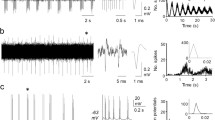Summary
Cats were used for microelectrode recording from single cells in the amygdaloid complex, and for fluorescence histochemical demonstration of monoamines. It was found that the firing rate of amygdaloid neurones decreased sharply following the administration of 5-HTP, the precursor of serotonin. Conversely, it increased after the administration of L-DOPA, the precursor of dopamine and norepinephrine. The fluorescence microscopy studies, after formaldehyde condensation, showed the presence of what appear to be axosomatic synapses containing serotonin on amygdaloid and hippocampal neurones. We conclude that serotonin may be an inhibitory synaptic transmitter in these limbic structures.
Similar content being viewed by others
References
Andersen, P., J.C. Eccles and Y. Løyning: Location of postsynaptic inhibitory synapses on hippocampal pyramids. J. Neurophysiol. 27, 592–607 (1963).
Blackstad, T.W., and P.R. Flood: Ultrastructure of hippocampal axosomatic synapses. Nature (Lond.) 198, 542–543 (1963).
Bogdanski, D.F., H. Weissbach and S. Udenfriend: Pharmacological studies with the serotonin precursor, 5-hydroxytryptophan. J. Pharmacol. exp. Ther. 122, 182–194 (1958).
Brookhart, J.M., A. Arduini, M. Mancia and G. Moruzzi: Thalamocortical relations as revealed by induced slow potential changes. J. Neurophysiol. 21, 499–525 (1958).
Dahlström, A., and K. Fuxe: Evidence for the existence of monoamine-containing neurons in the central nervous system. I. Acta physiol. scand. 62 (suppl.), 232, 1–55 (1964).
Eidelberg, E., M.K. Miller and M. Long: Spectrum analysis of electroencephalographic changes induced by some psychoactive agents. Int. J. Neuropharmacol. 5, 59–74 (1966).
Falck, B., N.-A. Hillarp, G. Thieme and A. Torp: Fluorescence of catecholamines and related compounds condensed with formaldehyde. J. Histochem. Cytochem. 10, 348–354 (1962).
Herz, A., u. A.C. Nacimiento: Über die Wirkung von Pharmaka auf Neurone des Hippocampus nach mikroelektrophoretischer Verabfolgung. Naunyn-Schmiedebergs Arch. exp. Path. Pharmak. 251, 295–315 (1965).
Kandel, E.R., and W.A. Spencer: Electrophysiology of hippocampal neurons. II. After-potentials and repetitive firing. J. Neurophysiol. 24, 243–259 (1961).
Kubota, K., H. Sakata, K. Takahashi and M. Uno: Location of the recurrent inhibitory synapse on cat pyramidal tract cell. Proc. Japan Acad. 41, 195–197 (1965).
Schanberg, S.M.: A study of the transport of 5-hydroxytryptophan and 5-hydroxytryptamine (serotonin) into brain. J. Pharmacol. exp. Ther. 139, 191–200 (1963).
Author information
Authors and Affiliations
Additional information
Supported by USPHS Grant NB-3496, General Research Support Grant FR-5575, USPHS Career Development Award NB-K3-15.437, and a grant from the Epilepsy Foundation.
Rights and permissions
About this article
Cite this article
Eidelberg, E., Goldstein, G.P. & Deza, L. Evidence for serotonin as a possible inhibitory transmitter in some limbic structures. Exp Brain Res 4, 73–80 (1967). https://doi.org/10.1007/BF00235218
Received:
Issue Date:
DOI: https://doi.org/10.1007/BF00235218



